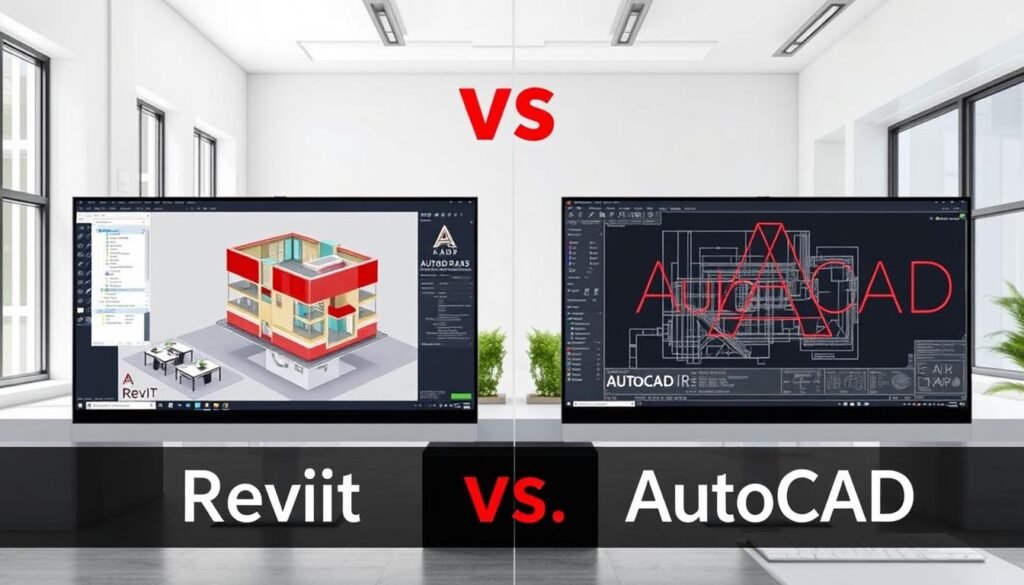Mastering BIM and Revit equips architects with a powerful toolkit to stay ahead in the fast-paced architecture industry. As the industry continues to evolve, the demand for professionals proficient in these technologies is on the rise.
Learning Revit before graduation can significantly enhance a student’s career prospects. By incorporating Revit into their skill set, aspiring architects can improve their design capabilities, collaborate more effectively with colleagues, and streamline their workflow.
Key Takeaways
- Mastering BIM and Revit enhances career prospects
- Revit improves design capabilities and collaboration
- Proficiency in Revit streamlines workflow and boosts productivity
- Revit is becoming an essential tool in the architecture industry
- Learning Revit before graduation gives students a competitive edge
The Evolution of Architectural Design: From Drawing Boards to BIM
The architectural design process has undergone a significant transformation over the years, shifting from traditional drawing boards to sophisticated Building Information Modeling (BIM) systems. This evolution has not only changed the tools architects use but has also fundamentally altered the design process itself.
As architects transitioned from manual drafting to computer-aided design (CAD), the industry saw its first major digital shift. However, it was the introduction of BIM that truly revolutionized the field by integrating various aspects of a project, such as structural engineering and building services, into a single, cohesive system.
The Digital Transformation in Architecture Practice
The digital transformation in architecture practice has been driven by the need for greater efficiency, accuracy, and collaboration. BIM software for architecture students has become an essential tool, enabling them to work more effectively and produce high-quality designs. This shift has also led to increased demand for professionals proficient in BIM technologies.

Understanding Building Information Modeling (BIM)
Building Information Modeling (BIM) is more than just a design tool; it’s a process that involves creating and managing digital representations of physical and functional characteristics of places. BIM integrates various data, including geometric information, spatial relationships, and other relevant details, making it an indispensable tool for modern architectural practice.
| Aspect | Traditional Design | BIM |
|---|---|---|
| Design Process | Manual drafting and 2D CAD | 3D modeling and data integration |
| Collaboration | Limited, often siloed | Enhanced, real-time collaboration |
| Data Management | Disparate, often inconsistent | Centralized, coordinated |
As the industry continues to evolve, BIM education has become crucial for architecture students, preparing them for the demands of modern architectural practice. By understanding BIM and its applications, future architects can enhance their collaborative design capabilities and improve project outcomes.
Revit in Architecture Education: Current State and Challenges
As the architectural, engineering, and construction (AEC) industry increasingly adopts Building Information Modeling (BIM), educational institutions face the challenge of incorporating Revit into their curricula. This shift towards BIM proficiency is driven by the industry’s demand for graduates who are not only familiar with Revit but can also apply its capabilities to real-world projects.
The Gap Between Academic Training and Industry Requirements
Many architecture programs struggle to bridge the gap between the theoretical foundations they provide and the practical, software-specific skills required by the industry. Revit courses for architecture students are essential in addressing this gap, offering hands-on experience with the software that is now ubiquitous in professional practice. However, the pace of change in industry requirements often outstrips the ability of academic programs to adapt their curricula.
Why Some Architecture Programs Still Resist BIM Integration
Despite the growing importance of BIM, some architecture programs remain hesitant to fully integrate Revit training into their curricula. Reasons include a focus on traditional design skills, limited resources for software and training, and a perception that BIM is a specialized skill rather than a core competency. However, revit training programs can help institutions overcome these barriers by providing structured learning paths and leveraging educational resources.

Reason1: Industry Demand for Revit Skills is Overwhelming
The demand for Revit-proficient architects is skyrocketing, driven by the industry’s shift towards Building Information Modeling (BIM). As a result, architecture graduates with Revit skills are finding themselves in high demand.
Job Market Analysis for Architecture Graduates
The job market for architecture graduates is becoming increasingly competitive, with a growing emphasis on BIM proficiency. Employers are seeking candidates who can hit the ground running with minimal training, and Revit skills are at the forefront of this requirement.
Entry-Level Position Requirements
Entry-level positions in architecture firms now frequently list Revit proficiency as a requirement. This shift reflects the industry’s move towards more integrated and collaborative design processes.
Career Advancement Opportunities
Not only do Revit skills enhance entry-level job prospects, but they also open up career advancement opportunities. Professionals with expertise in Revit and BIM are more likely to be considered for senior roles or specialized positions.
Salary Differences Between Revit-Proficient and Non-Proficient Graduates
Data indicates that professionals trained in BIM and Revit often command higher salaries compared to those using traditional CAD tools. This salary disparity underscores the value that employers place on Revit skills.
For instance, a survey of architecture firms revealed that graduates with Revit certification can expect a significant salary premium. This premium reflects the industry’s recognition of the value that Revit-proficient graduates bring to projects.
Reason2: Revit Enhances Collaborative Design Capabilities
Revit has revolutionized the architectural design process by significantly enhancing collaborative capabilities among various stakeholders. This capability is crucial in today’s complex architectural projects, which often involve multiple disciplines and teams working together.
Breaking Down Silos Between Architecture, Engineering, and Construction
Revit’s Building Information Modeling (BIM) approach allows architects, engineers, and construction professionals to work together more effectively. By using a shared project model, teams can reduce errors and improve coordination. For instance, structural engineers can directly link their models to the architectural model, ensuring that changes are reflected across disciplines.
Real-Time Collaboration Features That Transform Project Workflows
Revit’s real-time collaboration features enable multiple team members to work on the same project simultaneously, regardless of their location. This capability is particularly valuable in large projects where teams are distributed across different sites or countries.
Cloud Collaboration and Remote Work Advantages
With Revit, teams can leverage cloud collaboration to work on projects from anywhere. This flexibility is essential in today’s globalized architectural practice, where teams often consist of members from different regions. The benefits include:
- Increased productivity through simultaneous work on projects
- Improved communication among team members
- Enhanced flexibility for remote work arrangements
Interdisciplinary Communication Benefits
Revit facilitates better communication among different disciplines by providing a common language and platform. This leads to improved project outcomes through:
- Reduced misunderstandings due to clearer project data
- Enhanced coordination among architects, engineers, and contractors
- Better decision-making through data-driven insights
By incorporating bim software for architecture students into their curriculum, educational institutions can prepare students for the collaborative demands of modern architectural practice. Similarly, revit courses for architecture students can provide hands-on experience with Revit’s collaborative features, making them more competitive in the job market.
Reason3: BIM for Students Provides a Competitive Edge in the Job Market
BIM for students is not just a skill; it’s a strategic advantage that sets them apart in a crowded job market. As the architecture, engineering, and construction (AEC) industry continues to evolve, the demand for professionals proficient in Building Information Modeling (BIM) and Revit is on the rise.
Portfolio Enhancement Through Revit Projects
By incorporating Revit projects into their curriculum, students can significantly enhance their portfolios. Revit training programs enable students to work on real-world projects, demonstrating their ability to apply BIM principles in practical scenarios. This not only showcases their technical skills but also their capacity to collaborate and manage complex projects.
Interview Success Stories: How Revit Knowledge Secures Positions
Numerous success stories highlight how Revit proficiency has been a decisive factor in job interviews. Employers value candidates who can hit the ground running, and knowledge of Revit is often a key criterion. Students who have mastered Revit through Building Information Modeling education are more likely to stand out and secure desirable positions.
Demonstrating Technical Proficiency to Employers
In a competitive job market, demonstrating technical proficiency is crucial. By mastering Revit, students can show potential employers that they possess the skills required to drive projects forward efficiently. This technical expertise is highly valued in the AEC industry.
Standing Out Among Fellow Graduates
With many graduates vying for the same positions, having Revit skills can be a significant differentiator. Students who have invested time in learning Revit and BIM principles are better positioned to stand out among their peers, making them more attractive to potential employers.
Reason4: Revit Accelerates the Transition from Concept to Construction Documentation
One of the key benefits of learning Revit is its ability to expedite the process from design concept to detailed construction documentation. By utilizing Revit, architecture students can streamline their workflow, reducing the time and effort required to produce comprehensive construction documents.
Efficiency Gains in Project Development
The use of Revit in architecture education leads to significant efficiency gains in project development. As students become proficient in Revit, they can quickly develop detailed designs and construction documentation, allowing them to focus on the creative aspects of their projects.
Key efficiency gains include:
- Rapid creation of detailed designs and construction documentation
- Automated updating of designs and related documentation
- Enhanced collaboration among project team members
Reducing Errors and Inconsistencies in Design Documentation
Revit’s automated processes play a crucial role in reducing errors and inconsistencies in design documentation. By automatically updating related elements when changes are made, Revit minimizes the risk of human error.
Automated Scheduling and Quantity Takeoffs
Revit’s automated scheduling and quantity takeoff features enable students to quickly generate accurate schedules and quantity takeoffs, saving time and reducing the likelihood of errors.
Clash Detection and Problem Solving
Revit’s clash detection capabilities allow students to identify and resolve conflicts between different building systems, such as architectural, structural, and MEP components, early in the design process.
| Feature | Benefit | Impact on Project Development |
|---|---|---|
| Automated Scheduling | Accurate and timely schedules | Reduces project delays and costs |
| Quantity Takeoffs | Precise material quantities | Enhances budgeting and procurement |
| Clash Detection | Early identification of conflicts | Minimizes rework and reduces project risks |
Reason5: Early Mastery Allows Focus on Design Rather Than Software Learning
Mastering Revit before graduation enables architecture students to shift their focus from learning software to developing innovative designs. This early mastery is crucial in allowing students to allocate their time and resources more effectively, concentrating on the creative and technical aspects of architectural design.
The Learning Curve Challenge for New Graduates
New graduates often face a steep learning curve when they enter the workforce, particularly if they are not familiar with industry-standard software like Revit. This challenge can hinder their ability to contribute effectively to projects, as they may spend a significant amount of time learning the software rather than focusing on design development.
The learning curve associated with Revit can be daunting, involving a considerable amount of time to become proficient. By learning Revit early, students can mitigate this challenge, ensuring a smoother transition into the professional world.
How Early Adoption Creates Space for Creative Development
Early adoption of Revit allows students to explore the full potential of BIM, enabling them to create complex designs and models with greater ease. This proficiency opens up new avenues for creative expression, as students are no longer constrained by their lack of technical skills.
- Enhanced creativity through the ability to experiment with different designs and models
- Increased productivity due to reduced time spent on software learning
- Better collaboration with other professionals, such as engineers and contractors, through the use of a common language (BIM)
Transitioning from Technical Concerns to Design Innovation
As students become more comfortable with Revit, they can transition their focus from technical concerns to design innovation. This shift enables them to explore new ideas and push the boundaries of what is possible in architectural design.
Leveraging Automation for Creative Freedom
Revit’s automation capabilities, such as automatic generation of documentation and scheduling, free up students to focus on the creative aspects of their projects. By leveraging these features, students can explore more complex designs and iterate on their ideas more efficiently.
Optimal Timing: When to Start Learning Revit During Your Architecture Education
Determining the optimal time to introduce Revit into an architecture student’s curriculum is crucial for maximizing its benefits. The timing of Revit education can significantly influence how well students grasp Building Information Modeling (BIM) concepts and how effectively they can apply them in real-world scenarios.
First Year vs. Later Integration: Pros and Cons
Introducing Revit in the first year of architecture education can provide a solid foundation in BIM from the outset. This early start allows students to gradually build their skills throughout their academic career. However, it may also overwhelm students who are still adjusting to the fundamentals of architectural design. On the other hand, introducing Revit later in the curriculum, perhaps in the second or third year, ensures that students have a robust understanding of traditional design principles before diving into digital modeling.
- Early Integration Pros: Develops a strong BIM foundation early on.
- Early Integration Cons: May overwhelm students new to architectural design.
- Late Integration Pros: Builds upon a solid understanding of traditional design principles.
- Late Integration Cons: May delay exposure to industry-standard BIM tools.
Balancing Traditional Design Skills with Digital Proficiency
A balanced approach that integrates both traditional design skills and digital proficiency is essential. This balance ensures that students understand the principles of architecture and can effectively use tools like Revit to bring their designs to life. Revit courses for architecture students should be designed to complement traditional design education, enhancing students’ ability to collaborate and communicate effectively in the industry.
Effective Revit College Training Approaches
As the architectural, engineering, and construction (AEC) industry increasingly adopts Building Information Modeling (BIM), the need for proficient Revit training in colleges has become more pressing.
Effective Revit training is crucial for architecture students to gain a competitive edge in the job market. Colleges and universities play a significant role in shaping the next generation of architects by incorporating comprehensive Revit programs into their curricula.
Self-Learning vs. Structured Courses
When it comes to learning Revit, students have two primary options: self-learning and structured courses. Self-learning offers flexibility and the ability to learn at one’s own pace. However, it lacks the guidance and feedback that structured courses provide.
Structured courses, on the other hand, are often taught by experienced instructors who can provide valuable insights and hands-on training. Many educational institutions now offer dedicated Revit courses as part of their architecture programs.
Leveraging Student Versions and Educational Resources
Autodesk offers free student versions of Revit, making it accessible to students worldwide. Leveraging these resources is a cost-effective way for students to gain proficiency in Revit.
Online Learning Platforms for Revit
Online platforms such as Autodesk’s official training resources, YouTube tutorials, and specialized BIM training websites provide a wealth of information for students looking to improve their Revit skills.
University-Sponsored Workshops and Resources
Many universities also offer workshops and additional resources to support Revit training. These may include peer-to-peer learning sessions, Revit clubs, or access to online forums dedicated to BIM and Revit.
| Resource Type | Description | Benefits |
|---|---|---|
| Self-Learning | Learning Revit through online tutorials and personal practice | Flexible, self-paced learning |
| Structured Courses | Guided instruction through college or university courses | Instructor feedback, hands-on training |
| Student Versions | Free or discounted Revit software for students | Cost-effective, access to professional software |
| Online Learning Platforms | Websites and platforms offering Revit tutorials and training | Variety of learning materials, community support |
By combining these approaches, colleges can provide a comprehensive Revit training program that prepares students for the demands of the AEC industry.
Revit Certification and Professional Development for Students
As architecture students navigate their educational journey, obtaining Revit certification can significantly enhance their career prospects. Revit has become a cornerstone in the architecture, engineering, and construction (AEC) industry, and proficiency in it is highly valued by employers.
Autodesk Certification Options and Benefits
Autodesk offers various certification options for Revit, catering to different levels of proficiency. For students, achieving certification can be a significant resume booster. The benefits include:
- Enhanced Employability: Certified students are more attractive to potential employers.
- Industry Recognition: Autodesk certification is recognized industry-wide, validating a student’s skills.
- Competitive Edge: In a competitive job market, certification can be a key differentiator.
Building a Professional Development Roadmap
Creating a professional development roadmap is crucial for students aiming to maximize their career potential. This involves:
- Setting clear goals related to Revit proficiency and certification.
- Identifying relevant educational resources and training programs.
- Gaining practical experience through projects and internships.
Resume-Building Credentials
Revit certification is a valuable credential that can significantly enhance a student’s resume. It demonstrates to potential employers that the student has achieved a certain level of competency in BIM and Revit, making them more competitive in the job market.
Continuing Education After Graduation
The learning process doesn’t end with graduation. Continuing education is vital for staying updated with the latest software developments and industry practices. Students should be prepared to continue their professional development post-graduation, leveraging resources such as online courses and industry workshops to stay ahead.
Revit in the Broader Software Ecosystem for Architects
Understanding Revit’s place within the architectural software landscape is essential for modern architects. Revit is not a standalone tool but part of a comprehensive ecosystem that enhances architectural design, documentation, and collaboration.
Integration with Visualization and Analysis Tools
Revit’s capabilities are significantly enhanced when integrated with various visualization and analysis tools. These integrations allow architects to perform complex analyses, such as energy efficiency and structural integrity, directly within their design workflow. For instance, tools like Autodesk’s Insight provide real-time energy analysis, enabling architects to make informed decisions about building performance.
Complementary Skills: Grasshopper, Dynamo, and Other Plugins
Beyond its native capabilities, Revit can be extended with plugins like Grasshopper and Dynamo, which offer advanced parametric design and automation capabilities. Mastering these tools can significantly enhance an architect’s skillset, allowing for more complex and innovative designs.
Creating a Versatile Digital Skillset
To remain competitive, architects must cultivate a versatile digital skillset that includes proficiency in Revit, complementary tools, and plugins. This involves:
- Understanding the strengths and limitations of each tool
- Learning to integrate multiple software solutions seamlessly
- Staying updated with the latest developments in architectural software
Future-Proofing Your Technical Knowledge
As the architectural software landscape evolves, it’s crucial for architects to future-proof their technical knowledge. This can be achieved by:
- Engaging with continuous learning and professional development
- Participating in webinars and workshops on emerging technologies
- Experimenting with new tools and plugins to expand their skillset
Overcoming Common Obstacles in Learning Revit as a Student
Mastering Revit is a crucial skill for architecture students, yet several barriers stand in their way. As the architectural, engineering, and construction (AEC) industry continues to embrace Building Information Modeling (BIM), the demand for professionals proficient in Revit grows. However, students often encounter significant challenges when attempting to integrate Revit into their academic curriculum.
Hardware Limitations and Solutions
One of the primary obstacles students face is hardware limitations. Revit requires a robust computer system to run efficiently, which can be a challenge for students with lower-end hardware. To overcome this, students can:
- Utilize cloud-based services that offer access to high-performance virtual machines.
- Invest in external hard drives or upgrade their computer’s RAM to improve performance.
- Take advantage of student discounts on hardware and software.
Finding Time in an Already Packed Curriculum
Another significant challenge is finding the time to learn Revit amidst a demanding academic schedule. To address this, students can:
- Integrate Revit into their existing coursework by applying it to current projects.
- Participate in Revit training programs designed specifically for students, which offer structured learning paths.
- Pursue revit certification for students to demonstrate their proficiency to future employers.
Student Discounts and Resources
Students can benefit from various discounts and resources that make learning Revit more accessible. Autodesk, the developer of Revit, offers free educational licenses to students and educators. Additionally, many educational institutions provide access to Revit through their software libraries.
Peer Learning and Study Groups
Forming study groups or participating in peer learning initiatives can also help students overcome the challenges of learning Revit. By collaborating with peers, students can share knowledge, resources, and experiences, creating a supportive learning environment.
Conclusion: Embracing Revit as an Essential Component of Architectural Education
Embracing Revit in architectural education prepares students for the demands of the industry. As the architecture, engineering, and construction (AEC) industry continues to evolve, the importance of Building Information Modeling (BIM) and Revit skills becomes increasingly evident. By integrating Revit into their curriculum, architecture programs can provide students with a competitive edge in the job market.
The benefits of Revit in architecture education are multifaceted. Not only does it enhance collaborative design capabilities, but it also accelerates the transition from concept to construction documentation. By mastering Revit, students can focus on developing their design skills rather than struggling with software learning curves. As a result, BIM for students becomes an invaluable asset, allowing them to seamlessly integrate into industry workflows.
Revit in architecture education is crucial for producing industry-ready graduates. By incorporating Revit into their programs, educational institutions can ensure that their students are equipped with the skills required by top architecture firms. As the AEC industry continues to adopt BIM technologies, the demand for Revit-proficient professionals will only continue to grow.

